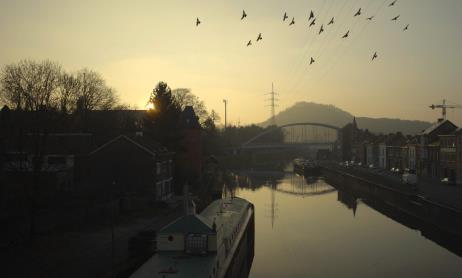(THIS ARTICLE IS MACHINE TRANSLATED by Google from Norwegian)
Before the State of Israel was founded, Stalin established an autonomous Jewish province farthest east of Russia at the border with China. The administration center was the town of Birobidjan, which is located along the Trans-Siberian railway. Any illusion that the Soviet leader was doing this for altruistic reasons disappeared when he initiated Jewish persecution in this area – 2 years after the province was founded in 1934. In the poetic and multifaceted documentary portrait Birobidjan from 2015, Belgian filmmaker Guy-Marc Hinant, who has a sensitive sense of places in disrepair, tried to find the links between the past and the present to this enigmatic Jewish settlement. His latest documentary, Charleroi, The Land of 60 Mountains, picks up the thread from the dream, which today is a distant memory, of the promised homeland.
A city with many possibilities
The film is inspired by the story of Benjamin Silberberg, who along with the family planned to emigrate to Birobidjan from his hometown of Charleroi in 1934. The journey never took place; they were drawn into the war and ended up in Auschwitz instead. The Belgian city of Charleroi, which is also the director's hometown, has turned out to be a kind of reverse paradise. The city, once a center of socialism, was also a safe haven for Jews who fled persecution in the pre-war period. But the city took an "unfortunate turn" after it resumed after the German occupation; several factories were closed and corruption crept into the mayor's office.
Today, Charleroi is notorious for being the city from hell where no outsider can imagine living. With fine-tuned antennas for the waves of longing and remorse flowing out of the city, Hinant revives Charleroi as a city of opportunity and provides a renewed insight into the city's irreducible diversity. He does this by digging through the endless threads of memories and events that have taken place in the city over the last century, to prevent the city from disappearing into the fog of oblivion.
"There are two worlds: the one on top and the one below," says a narrator's voice. A restless and searching camera glides around Charleroi. The city's abandoned industrial areas and slag heaps from the heyday of the coal and steel industry are visual consequences of the high unemployment and gloomy atmosphere prevailing in the city. The mood is charged. The camera gaze often moves in the twilight or darkness, as a return to the search for traces of the past it can bring to life. This approach sees places as more than just bricks, mortars and figures, rather as a unit of mixed mythology, which in turn shapes the inhabitants with random echoes and constellations.
To renew a blackened city
The approach is part of the tradition called psychogeography, a poetic practice perfected by postwar Jewish writers, such as Walter Benjamin, who wrote about anxiety and displacement. Psychogeography uses the details of urban exploration to open us to new perspectives on our surroundings. A quote by English cartoon legend and psychogeographer Alan Moore opens the film's journey through Charleroi: "There were fossil seams of ghosts." In other words, this is a city that not only literally excavated its wealth from underground mines; also the town's history is now ripe for excavation.
The ability to adapt is an ongoing project in a city that is itself in constant decline
change.
References to a number of characters associated with Charleroi are woven into the film, such as René Magritte. The Belgian surrealist and subversive left-wing radical married the daughter of a butcher from Charleroi, and Magritte's mother drowned in Sambre, the river that flows through the city. It has been proposed to name the streets of the city after academics and poets, instead of kings and soldiers, in order to utilize the symbolic power of the names – a recognition that cities appear in the frames and definitions we give them as much as in the raw reality that is visible to us. Hinant not only uses famous creative figures like orienteringpoints. We also get to meet a homeless and unemployed construction worker who lives in a tent camp in today's Charleroi, but hopes his skilled hands will soon make a comeback. The ability to adapt is an ongoing project in a city that is itself constantly changing.
If slag heaps were mountains
The title of the movie, Charleroi, The Land of 60 Mountains, refers to an architect's remark that if all the slag heaps had been preserved after the city's industry was shut down, there would have been 60 mountains in Charleroi today. However, the greatest force is given the survival urge when it comes to the inhabitants themselves, for the dream of a safe harbor did not only apply to Silderberg's family. A historian tells Hinant one of the most appalling and at the same time edifying stories of the city. In 1942, the Nazis asked for the name and address of all the Jews living in Charleroi (around 1300 pieces) to send them to "compulsory labor in Eastern Europe". Resistance activist Max Katz and his colleague provided them with a false list and managed to tell everyone except 23 victims to get away – an example of courage and resistance that is as important a part of the city's history as today's challenges.
A human being lives for about 70 years (if we're lucky), but the life of a city extends much further. Hinant's movie reminds us to have a broader perspective, and that if you just dig a little, you can discover something really valuable.


